If you're on the lookout for a new camera to take with you when you go fishing, there are a few things you need to consider before diving for your wallet. This article aims to point out some issues regarding size, facilities and accesories.
If you're on the lookout for a new camera that you can take with you when you go fishing there are a few things you need to consider before going for your wallet. This article aims to point out some issues, which are important to consider and light up some of the things you might be uncertain about.
What's most important?
You have all kinds of factors that can affect your decision:
- size and weight of the camera
- ease of use
- resolution and image quality
- facilities
- ruggedness
- price
...and probably a few other things.
Which one is most important then?
Some people will prefer a light and compact camera to a heavier one and rather sacrifice facilities.
Others might be on a tight budget and are willing loose some advantages to get a lower price.
Others again are dial freaks and want controls by the dozen no matter what.
I will let you do the deciding, but just try to enlighten you with respect to the different aspects. And I will dig into it from my own personal perspective.
If nothing else, then just to have somewhere to start.
Disclaimer
I have to warn you about this digital camera business. The development is so fast-paced that no matter what I write here, it's bound to be obsolete before I lift my fingers from the keyboard.
I will try to be as general as possible and not go into specifics about makes, models and numbers, but you will have to forgive me if you read this six months or a year from now and think "Hey, what a dork! Doesn't he know that...? Or hasn't he heard that...?"
No, I haven't! Because it probably hasn't happened yet, but will as soon as I publish this article.
Just to illustrate: several of the cameras shown in this article are now discontinued or their manufacturers out of business... And I'm considering changing to Nikon, but that's a whole other story.
Form factor
The first thing I would personally consider would be the size and general layout of the camera. I will refer to it as the form factor and I will divide the cameras on the market into four significant groups:
Compact Point and Shoot
The compact cameras aim to be as compact as possible. They are typically less than the size of a pack of cigarettes and will be smooth and flat when shut off. The lens retracts all the way into the body and there are no protrusions on the camera. The controls a few and integrated into the body. The LCD will sit smoothly on the backside and often there is no optical viewfinder. The camera has a small, built-in flash.
This is the perfect type of camera for the fishing photographer who wants something that packs away easily, weighs as little as possible and still has some facilities and image quality.
Medium size P&S
The medium size point and shoot camera is still quite compact. It will typically be more ergonomically shaped and have a grip for your fingers. It might have a dial and a few controls, mostly integrated well into the body. The lens will normally retract fully into the camera.
Some of these cameras have a twistable LCD, but most don't.
Most of them have a viewfinder, but some don't.
The flash is small and placed to the side on the front of the body.
This camera type usually offers a bit more in control and quality, but can also offer a lower price for the same quality as the smaller type mentioned above. Most best buys fall in this category, and unless you aim for a very small camera, it is very likely that you will find your optimum model in this group.
Combo or bridge cameras
Large combo cameras -- AKA bridge cameras -- are the most diverse of the bunch. They are built to satisfy the demanding amateur or the pro. In general they are fairly large, have a large, non-retractable lens, a large twistable LCD on the backside and maybe a supplementary LCD with technical information as well as many controls and dials. The flash is fairly large and in some cases of the flip-up type and these cameras all have viewfinders - some even of the through-the-lens type. Their shapes vary greatly, but only few of them are regular and in any way compact.
These cameras do not pack easily, but will offer more facilities, better optics, wider zoom range and altogether more options and controls. The price is their chunkiness. They do not pack easily, and in my opinion the step from here to a true SLR is small and definitely worth considering.
Single Lens Reflex or SLR cameras
The SLR cameras are big, professional type cameras with exchangeable lenses and lots of controls and accessories. They are aimed at the demanding photographer - amateurs as well as pros - and offer all the facilities and controls that you can imagine.
Most of them have very capable flip-up flashes and all of them have true through-the-lens viewfinders. They have large LCD's on the backside and in most cases one or two smaller LCD's for camera and exposure information as a supplement.
These are different beasts! They are large, heavy, complex - but also offering a superior quality, endless control and unsurpassed flexibility. The photographer who chooses this type of camera usually knows what he wants, has some prior experience with SLR's and don't mind a heavy camera bag - and a light wallet...
Recommended
My personal recommendation is a camera from the second group - the mid-sized point-and-shoot cameras. These will generally give you more bang for the buck, and have the facilities you will need. Don't go too low, though. Some of these cameras are downright lousy, particularly the non-brand ones found in shops that do not specialize in cameras.
The facilities
Consider all the following when choosing:
- As high a resolution as you can afford. The sensible limit is right now (primo 2006) about 6-8 megapixels, which will carry you a long way. For web use it's more than adequate, and for print use it will stretch to a Letter- or A4-format in a reasonable quality.
- A good lens, particularly in the wide end. Aim for a camera that has at least a 35mm wide-angle (measured as a 24*36mm film equivalent), but if a 28 or 24 mm is a choice, go for that. The tele-end is not nearly as critical, and about 70-100 mm film equivalent will do. And don't even read the specs for digital zoom. Don't use digital zoom!
- Macro facilities. Macro means getting really close, and good macro for taking flies, gear and details in nature usually means going as close as down to a couple of centimeters or an inch or less.
- A rugged camera. You want something that can take a beating. If a weatherproof camera is an option, it's worth considering, but at least choose something that does not feel too flimsy.
- A large LCD screen, preferably twistable so that it can be angled. The flip-out type of LCD gives some great advantages when shooting low or high.
- Good battery life. You don't want to run out of juice all the time, so get good battery life. And make sure the camera uses rechargeable batteries, preferably of a modern type like NiMH. Rechargeable AA cells will work fine too, but still fewer cameras use these standard batteries because of their size.
- Exchangeable standard memory cards. Don't even consider cameras with "built-in" memory. You want cards that can be changed and upgraded. There are several standards, but Secure Digital (SD) and Compact Flash (CF) are the most widespread and common.
- Manual flash override. You need to be able to determine whether the flash shoots ore not. And if that includes flash power control, so much the better.
Weather- and waterproof
You may consider buying a waterproof housing for your camera. These come at reasonable prices, and their only drawback is their size. Your camera will grow to become a large and quite clunky, but on the other hand be able to submerge and take pictures underwater. Should you be so inclined, you can even use it when snorkeling or diving.
Another option is to select a weatherproof or even waterproof camera from the setout. These are cameras, which in all cases will keep out rain, sand and splashes, in some cases even tolerate a dip and in a few cases can take pictures under water. They are not significantly more expensive than the non-weatherproof ones, but may lag a bit in facilities.
I have personally dipped my P&S in the water three times, and it has survived. But I still don't recommend doing so unless your camera is built to withstand the wet elements.
Accessories
Many cameras allow for a host of extras such as wide angle and telephoto adapters, filters, external flashes, remote controls and a lot of other nice-to-haves.
I would not let the access to these extras decide the choice of camera. Most of the accessories are fairly expensive, and unless your camera comes with them from the start as a package or you buy used from someone who already spent the money, you probably don't need to consider them.
If you want a lot of flexibility do yourself the favor of considering an SLR. Stay with the compact or medium size P&S-cameras if you just want something for quick and easy on-the-water images.
|
|
|
|
|
|
What I use
Have you ever asked a cook what stove a meal was cooked on?
Probably not...
You know very well that the stove has very little influence on the quality of a meal.
Same thing goes for cameras. I buy the best I can afford because I love good gear, but honestly: some of my best digital images have been taken with a 2 megapixel digital camera, which no one would probably bend down to pick up from the pavement if they found it. So don't worry too much about what others use, but get what you like and can afford or want to spend money on.
But people do ask me what I use, and to satisfy the curious reader I'm gonna list my equipment anyway. The list below is a dated list. This list with my gear is updated.
P&S (2006):
Canon A80, 4 megapixels, nice camera, flip-out LCD and very durable. I have shot close to 9,000 images in the 2 years I have had it. I bought it just because I liked it and the price was right.
The Canon replaced the above-mentioned 2 megapixels Nikon Coolpix 775, which I lent to a friend who used it until a few weeks ago, and it still takes some great pictures.
2014: I have since eaten my way through several Canon PowerShots and now have a waterproof D10, which is ugly, but an excellent angler's camera.
SLR (2005-2006):
I used to use a Minolta Dynax/Maxxum 7 for film. The camera love of my life. When I went digital on the SLR-front I bought a Konica Minolta Dynax/Maxxum 7D - the digital heir to the film 7. This is a great 6 megapixel SLR with enough facilities and buttons to satisfy even me. I chose it because I had a bunch of lenses and accessories already. Like:
- Sigma 24-70 mm, f2.8. Superior image quality.
- Vivitar 19-35 mm, f3.5-4.5, good and inexpensive wide angle.
- Sigma 16mm, f2.8 fish eye. Whoa!
- Minolta 50mm, f1.7, an extremely good lens and almost no cost.
- Tokina 100-300mm f4, a great telephoto lens, built like a tank.
- Sigma 90mm macro, tack sharp.
- Minolta 70-210, f4, known as "the beer can", great image quality.
- Minolta 5600HS flash.
- Angle finder.
The 7D took me about 30 images a day from I bought it some 14 months before this was written. That was close to 12,000 pictures by the way.
2014: I since exchanged the Minolta gear for Nikon, and now have several Nikon bodies (four to be precise) and quite a few lenses. See more here.
Tripod:
My old Slik tripod with a Gitzo G375 ball head needed replacement a year or so ago, and I bought:
- a Manfrotto 055Pro, sturdy, sufficiently light
- a Manfrotto Grip Action Ball Head, sturdy and really fast to use
- Several quick release plates for the above
2014: This has also been upgraded and I have now standardized on the Arca-Swiss system.
Keep it close
Always keep the camera ready. Don't pack it far away in an inner pocket, a camera bag or in your backpack on the bank. Keep it with you in the water.
I have my own P&S-camera in an industrial strength retractor just inside my waders, ready to shoot in seconds.
If you are nervous about water getting to the camera, consider packing it in a Ziplock bag - or maybe two. It delays you when you want to shoot and the fumbling with the bag is more dangerous in my eyes than the wet elements themselves, but can protect the camera in case you fall.
I have already mentioned that my own Canon A80 has been completely submerged for a few seconds three times - two of them in salt water - and it still takes pictures, although it does have some idiosyncrasies.
I also have a small photography site called 500th.net you can visit.
- Log in to post comments

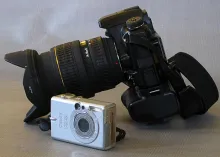
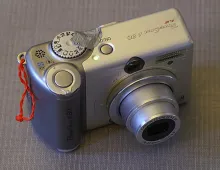
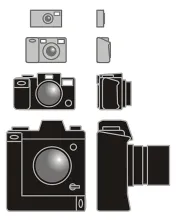
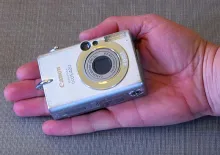
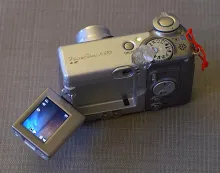
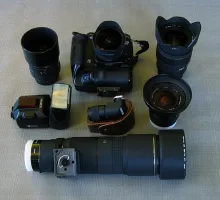
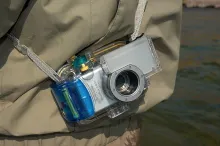
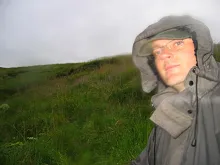
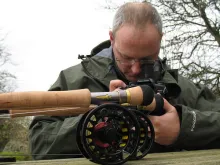
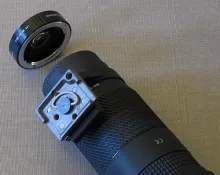
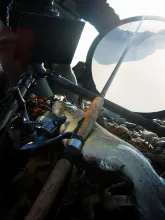
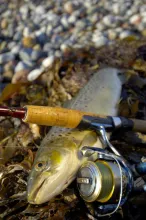
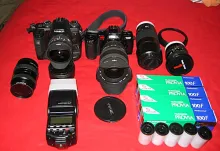
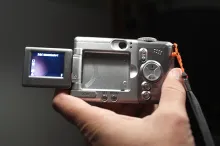
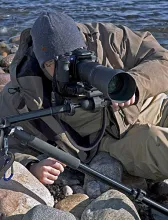
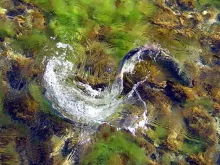
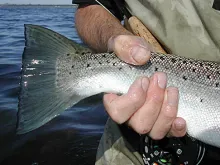
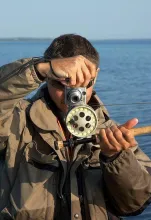
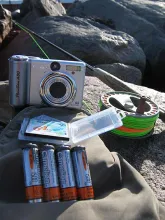
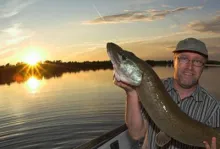
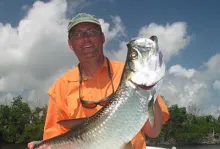
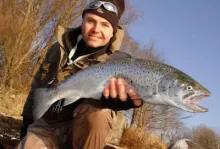
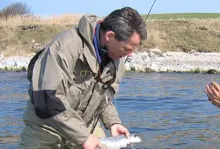

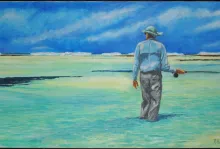

My father is a HUGE
My father is a HUGE Musky fisherman and has asked for a mountable camera for Father's Day to capture pictures of his catches before he sets them free. Any ideas?
Have enjoyed greatly
Have enjoyed greatly this article on photographic equipment. It's good to see what equipment other people use, I have been using a Canon G5 for a couple of years now, and it has a great range of features. Also have a Fuji A120, 3.2 mb, it's a naff camera ( the flash does'nt work ) but I have had some good pics with it.
I have also just invested in a Canon 400D, which is 10 million pixels, now I have to get round to buying a couple of decent lenses to go with it for my fishing pictures. Close up stuff I particularly like - because a lens can pick out information that an eye cannot see.
My eyes anyway!!!
The lastest "perfect
The lastest "perfect" fishing camera - from Fuji - the "Big Job" HD-3W - 6MP, ISO to 1600, 28-84mm equivalent wide zoom, submersible to 1 metre, can be dropped .7m shockproof. Takes AA batteries , built-in flash and a hot shoe!
A tough practical camera - I wonder if it will ever be sold outside of Japan?
Excellent series of
Excellent series of articles!!! My love of fly fishing and tying might become eclipsed by my new love for photography. I noticed on your website you now shoot with a Nikon D200, which is the same model I recently purchased, and I very much look forward to taking some crisp and beautiful fishing photos, hopefully sooner rather than later, with the help of your articles. I feel fortunate to have found the knowledgeable information you so generously share. Thank you!
Anike,
I don't th
Anike,
I don't think it's quite fair to complain about this article. Use the menu or the links and go to our gallery page. We have thousands of fishing pictures and extremely few of cameras!
You can even sumbit your own if you want to in our GFFpix-section.
Martin
i would like picture
i would like pictures of a fising rod. not camaras thats why i'm on fising galary hunt
Really enjoying your
Really enjoying your growing series on fishing photography. I always bring the camera along - recently have moved up to a DSLR which I reckon is the perfect one for fishing - an Olympus E-1 - relatively compact, but the biggest plus is it is *splash-proof* and the only comparable DSLRs (canon EOS 1 or Nikon D2 ) cost two or three times the price. Rain and saltwater are no problem , just rinse off under the tap at home!
Tom,
I know the P
Tom,
I know the Pentax cameras and was pretty close to buying one a while back. But I decided against it, mostly because my trusty Canon still was (and is) going very strong.
Once it gives in, I will certainly consider a truly waterproof camera. Olympus has one too, which I just saw this past week. Nice cameras both of them.
Martin
Hi Martin,
I like
Hi Martin,
I like your article. When I have to take pictures I normally use my Nikon digital SLR.
However when wading fishing, taking such an equipment with you, has some risks. For this purpose I purchased following P&S camera, which is waterproof for 1.5 meters! You can also use it easily with gloves and wet and slimy fingers. In my point of view an excellent sportfishermans camera: Pentax Optio WP
In your gallary you will find an example of the results. Look for my picture of releasing a small brown trout.